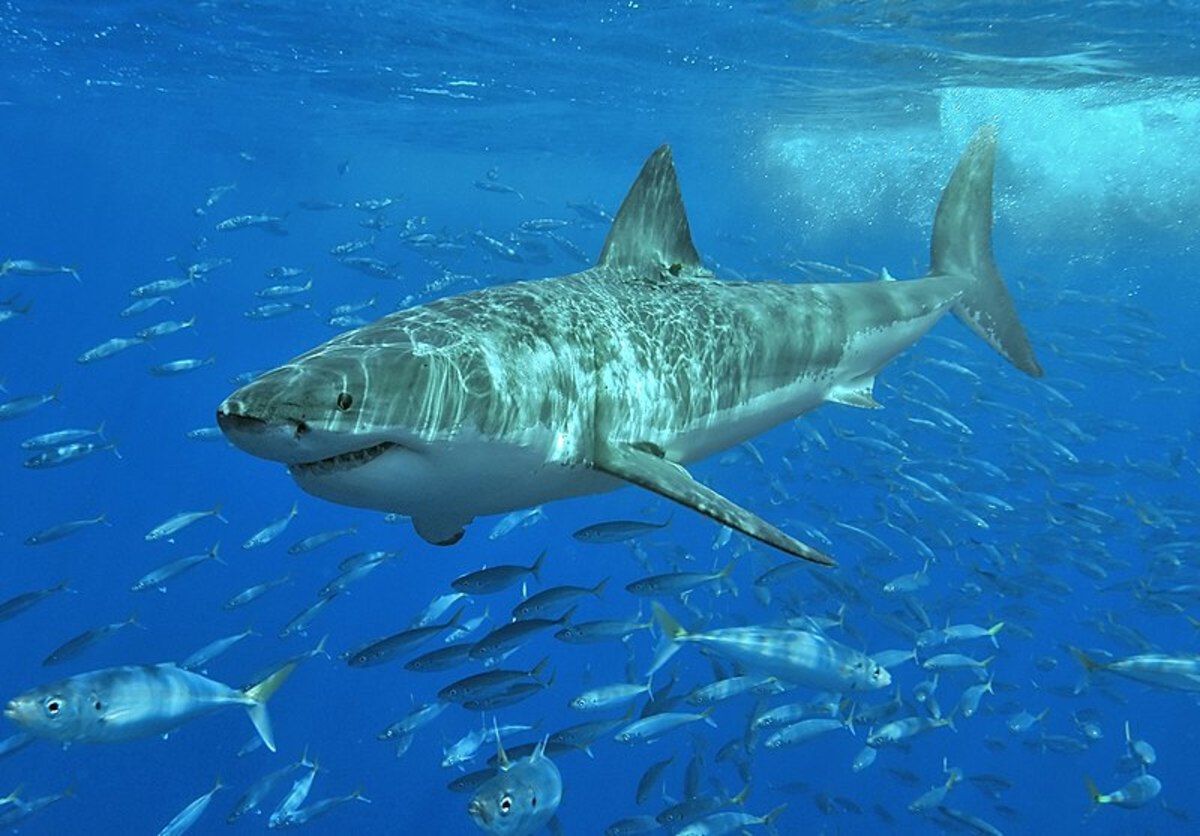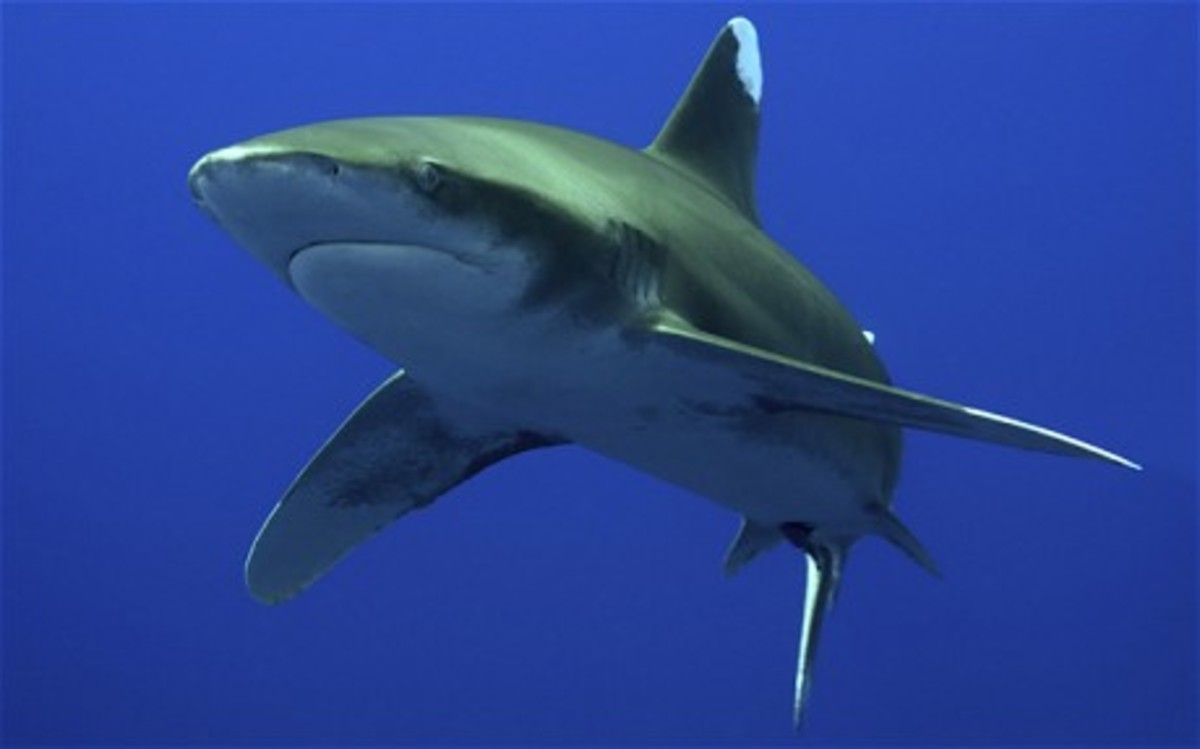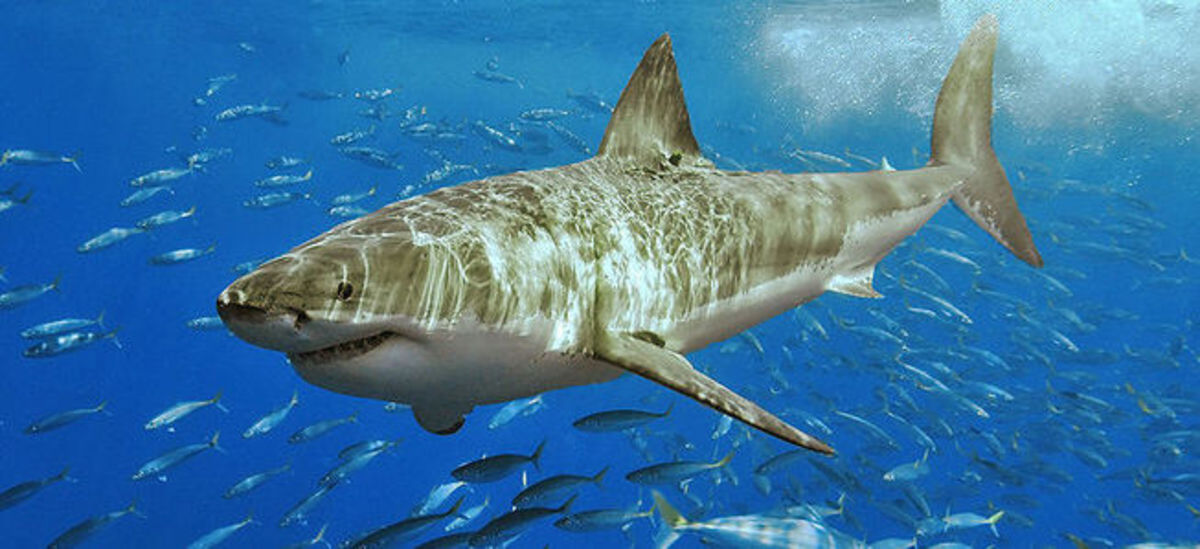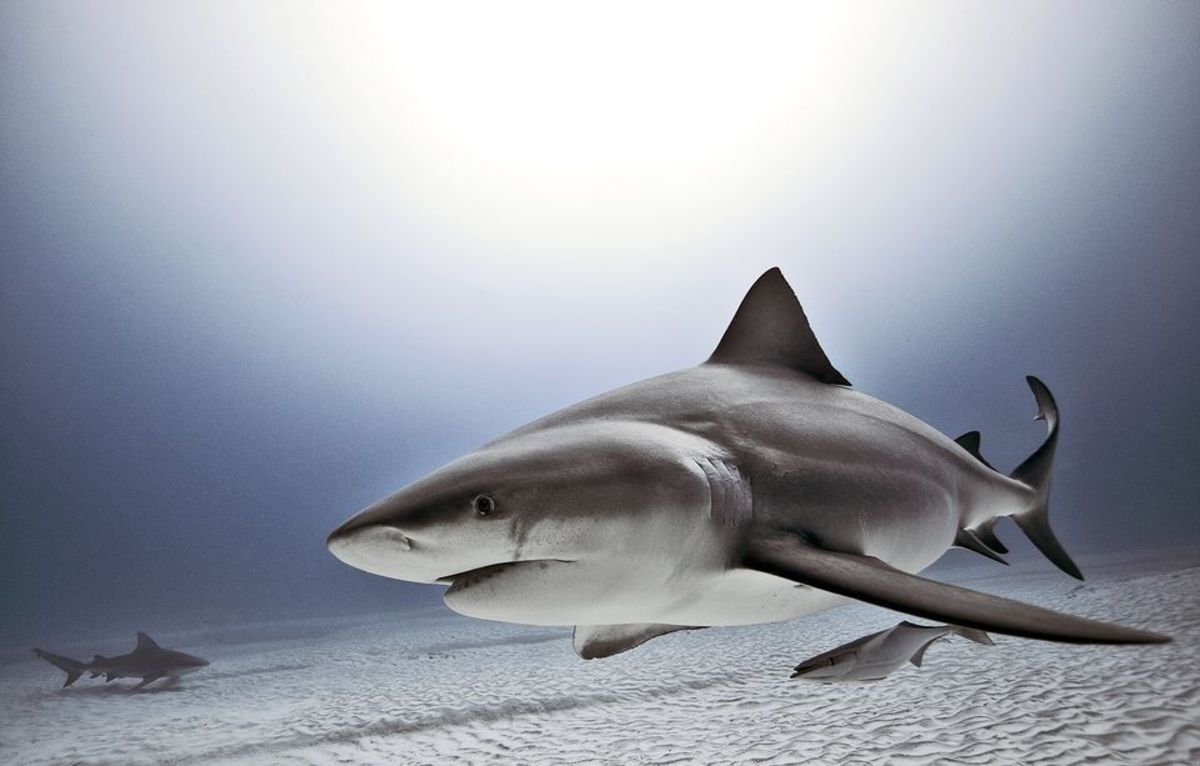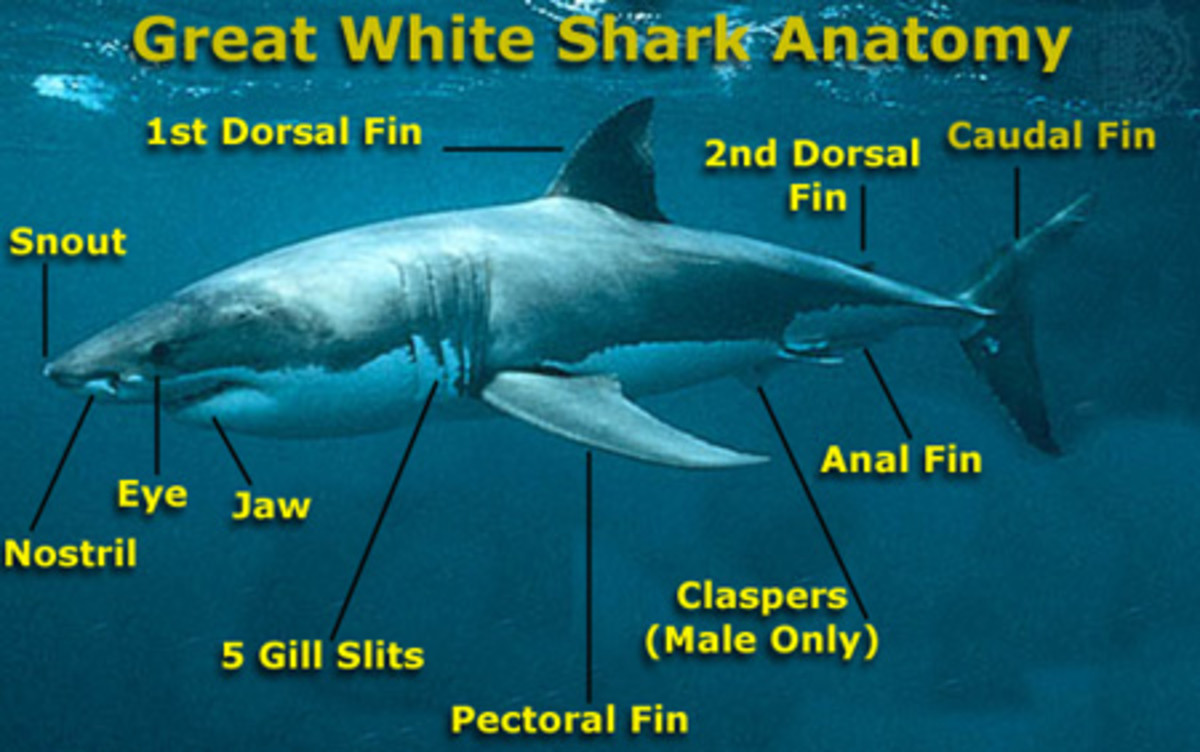- HubPages»
- Education and Science»
- Life Sciences»
- Marine Biology»
- Marine Life
The Hammerhead Shark - One of the Sea's Most Fascinating Predators
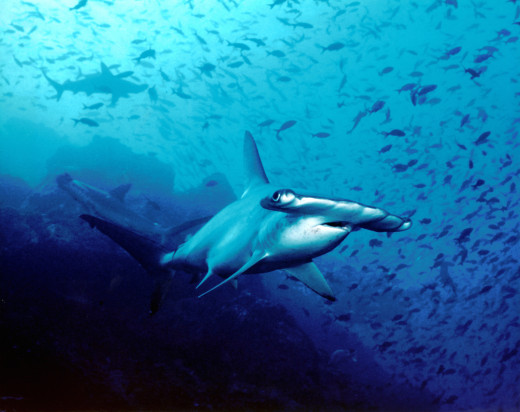
Physical Characteristics
The hammerhead has many unique physical characteristics, with the most immediately recognizable of these being - of course - its strange hammer-shaped head. The hammer-shaped portion of the head is called the cephalofoil. There are nine distinct species of hammerhead and all can be identified by the variations in the shapes and sizes of their cephalofoils.
The great hammerhead has a wide and nearly flat cephalofoil, while the smooth hammerhead's cephalofoil is actually flat across the front. The scalloped hammerhead has a notch in the center of it's cephalofoil and two more notches symmetrically placed on either side of the center notch. The bonnethead hammerhead's cephalofoil is very rounded and more closely resembles a shovel than a hammer. The five other species have similarly distinct shapes to their cephalofoils.
The scientific community is not entirely sure what the evolutionary purpose the hammerhead's cephalofoil plays. Many marine biologists observe that while swimming the hammerheads seem to have a nearly panoramic view of the waters around them. Some scientists believe that the shape of the head is designed for easier maneuverability, noting that hammerheads are able to easily outmaneuver other sharks - but this attribute may be a result of the extreme flexibility of the rest of the hammerhead's body rather than the shape of the hammerhead's head.
One of the most plausible explanations has to do with the placement of the electrical sensors (called ampullae of Lorenzini, for researcher Stephan Lorenzini) all sharks have in their heads and noses. These sensors are used to detect prey, and perhaps the best explanation for the existence of the hammerhead's cephalofoil is that it spreads these electrical sensors out over a greater surface area than in most sharks, allowing the hammerhead to find some of its favorite meals more easily than other sharks do. This may explain the relative ease with which hammerheads appear able to find tasty meals such as stingrays camouflaged and buried in the sand on the ocean's floor.
In addition to this shark's characteristic cephalofoil the hammerhead has a few other lesser -recognized distinguishing features. The hammerhead has a much smaller mouth in comparison to the size of its head than most other sharks. Also, the hammerhead's sickle-shaped dorsal fin is very tall and can stick very high out of the water when the shark is cruising just below the surface in shallow waters.
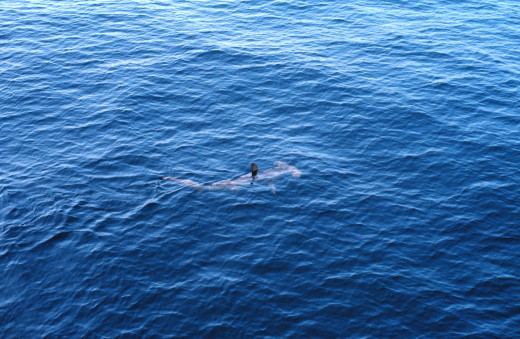
Habitat
Although a few species such as the whitefin hammerhead and the smalleye hammerhead have very limited distributions, hammerhead sharks are found all over the world. Hammerheads are primarily found in shallow, often tropical waters, but are not unknown in deeper or cooler waters. Many species of hammerhead including the largest hammerhead - the great hammerheads - have been found to travel quite far from shore, and smooth hammerheads are known to frequent cooler waters as far north as Canada.
Typically, however, hammerhead sharks are found in shallow waters and prefer warm-temperate or tropical regions. Hammerheads are often found very close to shore, in 900 feet of water or less, and are fond of bays, gulfs and inlets. Some hammerhead sharks have even been found in fresh water. Smooth hammerheads are the most widely distributed hammerhead shark and they have been spotted in the fresh water of Indian River, Florida.
Diet
The relatively small mouth of the hammerhead is filled with small sharp teeth in the front and very hard flat teeth in back. These hard and flat back teeth function much the way that molars do in humans - in the shark's case grinding up shellfish, crustaceans and other tough but prized hammerhead fare.
The hammerhead has a more interesting diet than many of its cousins - of course that diet includes large fish as a staple, just as the diets of other large shark species do, but thanks to the hammerheads' molar-like back teeth these sharks frequently dine on shrimp, crabs, squid, smaller sharks, stingrays, octopus, and other bony fish. Scalloped hammerheads have even been known to eat seagrass from time to time!
Many species of hammerhead have been known to resort to cannibalism, eating smaller hammerheads and even eating their own offspring.
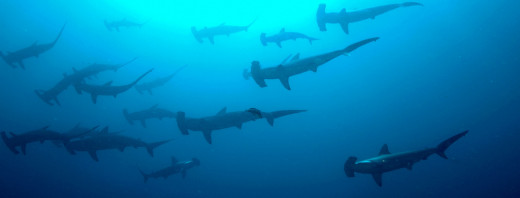
Reproduction
Female hammerhead sharks give birth to live pups and separate themselves from their young immediately after birth. The female will give birth to anywhere from 4 to 42 pups, depending on how large a shark the mother shark is. It seems that male hammerheads prefer mating with larger female sharks, which is perhaps explained by the ability of larger females to produce more young than smaller females are.
Though most species of hammerhead are solitary, scalloped hammerheads live and hunt in groups called schools. Males are outnumbered by females by about six to one. When scalloped hammerheads are ready to mate, the largest females congregate in the center of the school. A male suitor will swim into the center of the school, select a breeding partner from among the largest of the female sharks, and will swim off with her to mate. She will carry the pups for 8 to 10 months before giving birth in shallow water.
The pups are born with soft hammers which are curved backwards towards the tail to make it possible for the hammer shape of the head to pass through the birthing canal. Pups are about a foot and a half long each when born - while adult scalloped hammerheads are around 13 feet long. With so many pups in each litter it is easy to see why male sharks prefer large mating partners! Each pup takes up a lot of space inside of mom! Much like a human baby's head, the baby hammerheads' heads are soft to facilitate easier birthing, and the head returns to its proper shape and hardens up as the baby shark begins to grow. Baby hammerheads have a high rate of survival to adulthood and can expect to encounter few natural enemies in the oceans; with a few exceptions, including adult hammerhead sharks.
Less is known about the breeding habits of the solitary species of hammerhead sharks, but it is known that like many other species of shark, female hammerheads are capable of storing a male's sperm for months or years until conditions become ideal for pregnancy.
One particularly interesting study authored by an international team of researchers (Dr. Demian Chapman, Dr Mahmood Shivji, and Dr Paulo Prodöhl) found that female hammerhead sharks are even able to give birth without the assistance of a male partner, becoming pregnant through a process known as parthenogenesis - more commonly known as "virgin birth." According to that surprising study, it is possible for female hammerheads to reproduce asexually in cases where they have no access to male sharks
Life Cycle
After birth, young hammerheads must pursue the same food sources as adults do, without themselves being spotted by a hungry adult hammerhead. Juveniles must learn to hide well when adults of their species are around, and it is not until they reach sexual maturity that they can begin to relax around others of their own kind.
For female scalloped hammerheads, sexual maturity does not occur until they are about 15 years old and at least six feet long. For males of the same species sexual maturity is reached much sooner at around age six when the sharks are about four and a half feet long. However, when food is scarce adult hammerheads are known to eat other adult hammerheads as a last resort in alternative to starvation.
Thirty years is considered an old shark for any species of hammerhead. Hammerheads average a lifespan of somewhere between 20 and 30 years.

